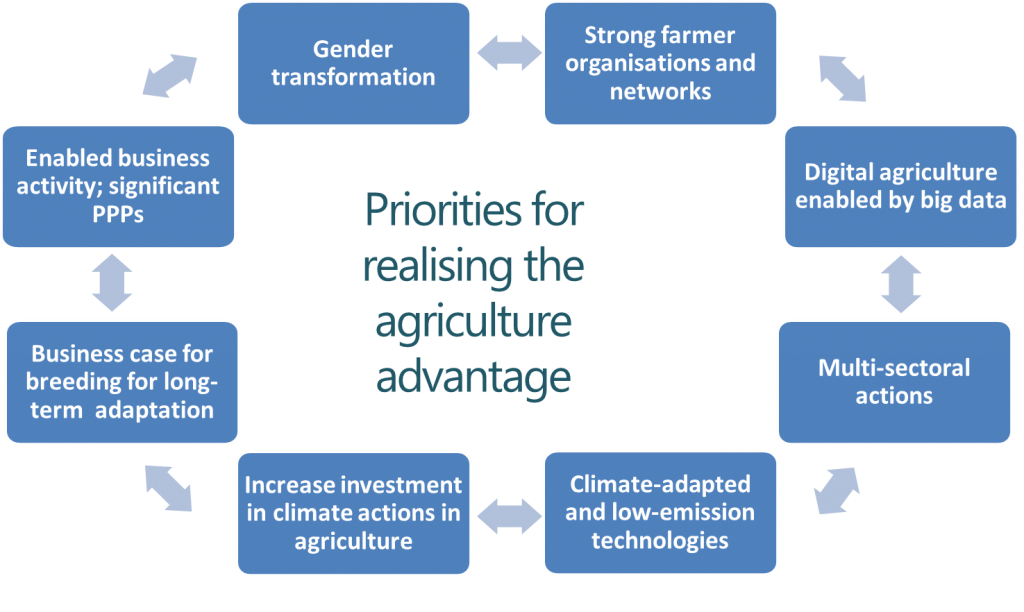Realising the agriculture advantage in climate action

The Agriculture Advantage event series at COP23 put forward a vision and action agenda for transforming agriculture under climate change.
At COP23, over 400 participants gathered to discuss the Agriculture Advantage, i.e. the various benefits of climate action in agriculture, to build a case for investment in transforming the sector. The week-long series of 8 events, set a vision for transforming the sector, and discussed various dimensions of the transformation, including gender, sustainable land and water management, crop breeding, public-private partnerships, science-policy interface and financing low emissions development pathways. The event series concluded with a high level closing event, which highlighted the priorities for transformation and called for greater investment in climate action in agriculture.
The Agriculture Advantage event series was hosted by the CGIAR Research Program on Climate Change, Agriculture and Food Security (CCAFS), the International Fund for Agricultural Development (IFAD), the German Development Institute (DIE), the Syngenta Foundation for Sustainable Agriculture, the Technical Centre for Agricultural and Rural Cooperation (CTA), and the Crop Trust, in partnership with various other organizations with the vision to transform agriculture under climate change.
Priorities for realising the agriculture advantage
Faced with the triple challenges of achieving food security, adapting to the impacts of climate change, and mitigating emissions, the agricultural sector must transform within the next decade, to secure the livelihoods of those dependent on the sector, to achieve food security goals, and to achieve climate change goals set out in the Paris Agreement. The Agriculture Advantage event series discussed various dimensions of this transformation, and identified a set of priorities for realising the agriculture advantage:
- Gender transformation: Women are 43% of agricultural labourers (over 60% in Sub-Saharan Africa, South Asia and Oceania), and a feminization of agriculture can drive the transformation needed in the sector. Incentives for women as part of a transformation agenda has also shown to improve nutrition and food security.
- Strong farmer organizations and networks: A transformation in agriculture is not possible without strong farmer organizations and networks. Research, finance and information sharing efforts should take cognizance of aspirations, issues, and drivers of farmers, and make farmers an integral part of the transformation.
- Digital agriculture enabled by big data: In the digital era, information is power, but agriculture has fallen behind other sectors in utilizing digital tools, and there is huge potential to change this, and use digital tools and big data to support the transformation needed in the sector.
- Multi-sectoral actions: The transformation in agriculture is not going to come from actions in the agricultural sector alone, it needs to be supported by actions in other sectors, e.g. in the financial sector to support the development of insurance schemes for farmers, in the information and communication technologies sector, to provide farmers with digital tools, and the infrastructure sector to enable connectivity with markets.
- Climate-adapted and low emissions technologies: There are a number of innovations in agriculture which can help farming communities and countries to adapt to climate change. However, it is important to take cognizance of the co-benefits which these innovations can deliver for climate change mitigation, as 24% of global emissions come from the sector.
- Increase investment in climate actions in agriculture: Current levels of climate finance to agriculture are miniscule, only 2.5% of public climate finance is reaching the sector, this needs to change. Opportunities include blended finance, private sector finance, and impact investment models.
- Business case for breeding for long term adaptation: Up to 30% maize and banana growing regions and up to 60% beans growing regions are projected to become unviable by the end of the century. Crop breeding can offer solutions by breeding varieties resistant to heat, drought and salinity, but crop breeding takes time(average crop breeding process can take nearly two decades). Therefore a sound business case for breeding for long term adaptation is a priority.
- Enabled business activity and significant public-private partnerships: Public private partnerships are crucial to scale up climate actions in agriculture, and there needs to be greater focus on leveraging private investment through public efforts.

Next steps: translating priorities into action
What should the international community do to translate these priorities into action? The event series identified the following next steps:
1. Scale up climate finance in agriculture: Agriculture only receives 2.5% of public climate finance, yet it is crucial to achieving food security, securing livelihoods of over 500 million smallholder farmers, and meeting the 2oC target set out in the Paris Agreement. Therefore, efforts should be made to scale up climate finance flows into the sector, both through the UNFCCC’s finance mechanism, as well as other institutional and private sector investors. |
2. Foster South-South cooperation efforts: A wealth of knowledge exists in terms of climate action in agriculture in developing countries. Many of these can be transferred and adapted with ease by interested countries with similar conditions. Efforts are needed to foster South-South cooperation, to realise the full value of the knowledge which exists. |
3. Develop partnerships for climate action in agriculture: Effective action requires strong partnerships with multiple stakeholders: investors, scientists, farmers, development practitioners and the private sector. Mechanisms and platforms to foster partnerships at global, regional and national levels should be prioritised. |
4. Transform agriculture research for development: A transformation in the agricultural sector needs to be supported by a transformation in the way research supports decision making. Agriculture research for development needs to transform itself to support rural transformation outcomes. |
5. Farmer-led action: Actions in the agriculture sector needs to be inclusive and farmer led, enabling farmers to cope with and indeed prosper under a changing climate. The gender gap in access to resources and technologies, along with social and cultural attitudes restricting women’s and girls’ rights, mean they need to be especially targeted and empowered. |
6. Transition to a low carbon development pathway: The need to mitigate emissions from agriculture can no longer be ignored, there is a need to move from viewing this as a challenge to an opportunity to transition into a low carbon development pathway. Many of the sound practices in agriculture – for adaptation and food security – have positive co-benefits. |
With the momentous decision on agriculture at COP23, there is an opportunity for the agricultural development community to step up to meet the challenges posed by climate change. We hope that these priorities will contribute to realising the agriculture advantage in climate action.
READ
- A step forward for agriculture at the UN climate talks – Koronivia Joint Work on Agriculture
- Read about the Agriculture Advantage event series
- Read the summaries of the Agriculture Advantage side events on the CCAFS blog
- Working Paper: 10 best bet innovations for adaptation in agriculture: A supplement to the UNFCCC NAP Technical Guidelines
WATCH
- Video: Agriculture Advantage: The case for climate action in agriculture
- Event recordings: CCAFS at COP23 playlist
- Presentations: CCAFS Slideshare
- Photos: CCAFS Flickr
Dhanush Dinesh is the Global Policy Engagement Manager at CCAFS.
